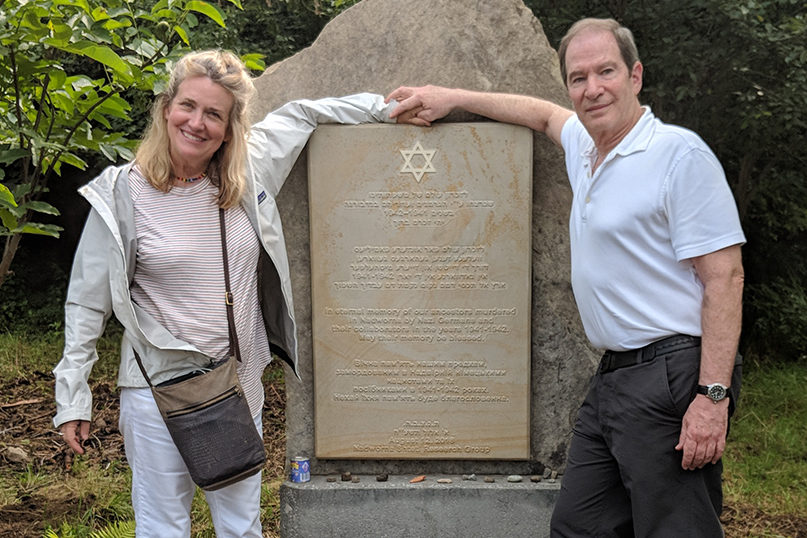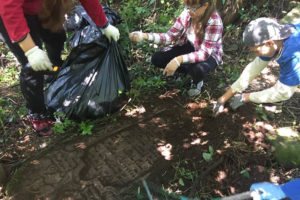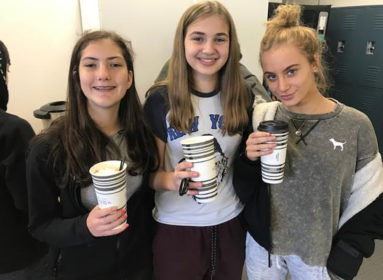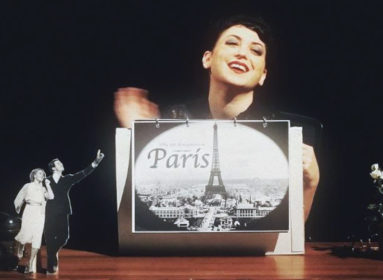
By Stacey Dresner
When Leslie Nolan joined the Peace Corps and landed in Nadvirna in Western Ukraine in 2017, one of the first things she saw was the town’s old Jewish cemetery.
“It was winter and there was snow all over, but I saw this cemetery and I was really struck by it on a number of levels,” Nolan recalls. “It was so large and the earliest stones dated from the 1640s…The word I used to describe it in something I wrote was ‘hauntingly beautiful.’ It just had this presence.”
For the past two years Nolan, a resident of Southport, has been working to clean up the cemetery with the help of a group of teenagers from Nadvirna.
Also involved in the effort are New Yorker Steve Turner, founder of the Nadworna Shtetl Research Group, which uses the Yiddish spelling of the town’s name; and the Eastern Europe Jewish Cemeteries Initiative (ESJF), which, funded by the German government and private donations, helps restore Jewish cemeteries in central and eastern Europe. Founded in 2015, ESJF has so far helped to fence in 100 of the thousands of Jewish cemeteries that are in need of restoration.
In Nadvirna, ESJF has pledged 15,000 of the 30,000 euros needed to pay for a fence that would be built around the five-acre, 5,000-gravestone cemetery. But ESJF stipulates that a matching 15,000 euros must also be raised for the group to get their funding. The deadline for raising the extra 15,000 euros was to have been last fall, but it has been extended to this spring. Turner would not say how much money they have raised thus far, and he isn’t optimistic that they will be able to raise enough.
“It’s not going well,” says Turner. “They want us to match that 15,000, and you know, we’re a group of mostly senior citizens. We are not wealthy people.”
A Family’s Roots
Nadvirna is located in the area of Central and Eastern Europe once known as Galicia, parts of which over the years went back and forth between Austrian, Russian and Polish control. Today the town is located close to the western border of Ukraine.
Nadvirna was the birthplace of one of the most famous Chasidic rebbes, Rabbi Mordechai Leifer of Nadvorna (1824–1894), son of Rabbi Yissachar Dov Ber Leifer of Nadvorna. Chasidim from all over Eastern Europe would travel to Nadvirna to receive the Rebbe’s blessings. Busloads of Chasidic men still travel to Nadvirna to pray at the cemetery.
Steve Turner’s father, Morris, was born in Nadvirna in 1910 when it was part of Poland. It was Morris’ mother’s hometown. When World War I broke out, Morris’ father was drafted into the Austrian Army and left to fight in the war. Nadvirna became part of the war front, and Morris’ mother became a refugee, taking her five small children from shtetl to shtetl to find food and shelter. When their father returned from the war, the family was reunited and they relocated to Vienna.
In 1939, and after a few harrowing incidents with the Nazis, Morris, 28, made it out of Vienna with his widowed mother. They came to the U.S., where a sister had settled in Chicago.
In Europe, Morris’s brother was sent to a work camp in Khazakistan but he survived and made it to the U.S. after the war. Another sister died of tuberculosis before the war. And Morris’ oldest sister, who had been the only one to stay in Nadvirna, was killed with her husband and their son.
At one time more than 60 percent of the population of Nadvirna was Jewish. After World War II, nearly all of the Jews in the town had been murdered.
Despite what happened to the Jewish population of Nadvirna, Turner says he has always had an interest in his father’s hometown.
“My father would always talk about how he was from Nadvirna but he didn’t have much of a memory of it. And I was always fascinated by Galicia,” Turner says. “We used to go to a shul in Brooklyn for the holidays, where my maternal grandparents lived, and it was a ‘Galiciana’ shul. I guess it was mostly Holocaust survivors in the shul, and I was always struck by them. Their warmth and how these people survived. I always had this place in my heart for it.”
Making Connections
Today Turner lives on New York’s Long Island, but has Connecticut connections: his son Elliot Turner lives in Stamford and his sister, Susan Wexler, lives in Westport. Both are members of the Nadworna Shtetl Research Group.
Last year Turner planned a trip to Nadvirna with some of his Nadworna Shtetl group. Several members were already planning to attend an International Association of Jewish Genealogical Societies convention in Warsaw, Poland. “I said, ‘Let’s make a trip to Nadvirna from there and let’s all go together,’” Turner said.
He made contact with Leslie Nolan through a mutual friend who runs another shtetl group, and the two began to email back and forth.
Sixteen members of the Nadworna Shtetl Group ended up making the trip to Nadvirna on Aug. 12. Accompanied by Rabbi Moshe Kolesnik of nearby Ivavo-Frankovsk, they attended a reception and luncheon thrown by the mayor at City Hall.
“They miss their Jews terribly there,” Turner says, with a little laugh.
When asked if he is serious or being sarcastic, Turner allows that, “They welcomed us very, very warmly. So there is a little bit of sarcasm in there, but they welcomed us warmly. Leslie was wonderful. She played a big part in organizing our day there.”
Nolan also had found the stone and stonemason for Turner who wanted make a memorial to the Nadvirna Jews lost in the Holocaust. The memorial was dedicated at a ceremony led by Rabbi Kolesnik at the cemetery.
“We gave testimonies about our ancestors in Nadworna in front of the community and all of the high school students, and [the teens] had never heard these stories,” Turner says.
He added that the only Jews that most of the local Ukrainians had ever seen are the Chasidim who travel in to pray at the ohel – the structure covering the graves of the Rebbes – and who then leave without making contact with Nadvirna residents.
“One of the positives of all of this was that these kids hit it off famously with the shtetl group and in fact many of them are now friends on Facebook and in touch,” Nolan says.
One of the American women who came on the trip went home to Denver and began a book drive for the Nadvirna teens’ library and ended up sending a large package of books – including a number of Harry Potter books.
“So it all comes around,” Nolan said.
Getting Teens Involved
Nolan, who is not Jewish, says that she had always wanted to join the Peace Corps and once her children grew up and left home, she did. Her years of experience in the non-profit and museum world – working at the Museum of the City of New York, the Whitney Museum of American Art, and the Wilton Historical Society – prepared her for her Peace Corps assignment in Nadvirna, working in tourism and community development.
“I’ve always worked for non-profit art organizations. You have to write grants, do exhibitions, do programs, websites, marketing…When you work for non-profits, you wear a lot of hats,” she says.
When she first saw Nadvirna’s Jewish cemetery in 2017 it was in the winter, “so it was kind of barren and you couldn’t really find any paths. You could see the stones sticking up,” she says. “Then in the spring when I could really see it, everything was growing up around and hiding stones. The growth was just rampant.”
Nolan says she met the group of local teens who were working on community service projects like starting a library and an anti-plastic campaign, and suggested they also help to clean up the Jewish cemetery.
“It was really interesting because they all wanted to get involved in the cemetery,” she says. “So this past summer when they were off from school we decided to do a massive cleanup.
“It was so overgrown you couldn’t walk through it; it was almost like a jungle,” she said. “We used machetes and cleared, and literally made trails throughout the cemetery. We also found two people living in the cemetery there and they had quite a set up. We cleared three big truckloads of trash. These kids really rolled up their sleeves and stepped up to the plate.”
Nolan’s husband, Doug Bennell, made contact with David Weisberg, CEO of Federation for Jewish Philanthropy of Upper Fairfield County, who connected him with a consultant for ESJF.
When asked why as a non-Jew she has become so invested in a Jewish cemetery in the middle of the Ukraine, Nolan explains, “It was the history, and the fact that this town had at one point been 70 percent Jewish. Now I am told there are three Jewish people who live in the town.
“One of the things that is heartbreaking to me is the kids don’t get much education about all this and the Jewish history,” she notes. “That is another reason why it was so good for these teenagers to meet this party and the rabbi and hear their prayers and their stories. All 16 of the Nadworna Shtetl group got up and gave their story. It was translated into Ukrainian and it was very powerful. It stayed with all of us.”
Nolan hopes that someday local schools bring their students to the cemetery to teach them not just about the Holocaust but about the town’s Jewish history as well.
“As I often said to the teenagers and the people out there, ‘This is your history. It’s not just Jewish history. This cemetery is everyone’s history. It’s there. It exists.’”
For more information contact nadwornashtetlrg@gmail.com.
CAP: Leslie Nolan and Steve Turner, at the memorial to the Jews of Nadvirna who were killed during the Holocaust.








 Southern New England Jewish Ledger
Southern New England Jewish Ledger











